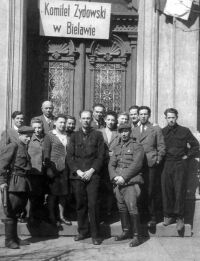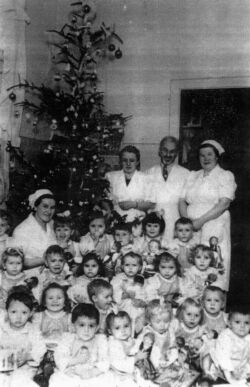





Jewish children saved from death in Lublin's district, Lublin 1946. The number of the saved children is estimated at about 5 thousand. Only few of them were lucky enough to keep at least one parent. In some cases they had been hiding in Polish homes (often pretending to be orphan relatives), others survived in convent or public orphanages.
J. Boruchowicz memorial tailor's cooperative "Zgoda" ["Concord"] in Wrocław, furrier's department, 1946 r. During the first few years after the war the Jewish cooperative movement was in its heyday. There dominated cooperatives of clothing, leather, food and hardware industries.
Pogrom in Kielce. The funeral of the casualties. The Jews were being killed with wooden poles, stones, shots in a head. They were being thrown out of the windows, drown in the river, and the dead were being stripped of their clothes and shoes.
Pogrom in Kielce. The funeral of the casualties. The authorities forced the active participants of the pogrom to take part in the funeral.
The Jewish survivors from the pogrom at the celebrations of its 50th anniversary. Kielce, 7th July 1996.
|

Jewish Committee in Bielawa, 1945/1946. The vast majority of the Jewish repatriants from the Soviet Union was sent to so called Recovered Territories (nothern and western parts of Poland). In Bielawa they were in a majority.
Scene from the play "Dybuk" played between 1951 and 1956. Virtually directly after the end of the German occupation there revived and then rapidly developed Jewish theatres. By the end of 1950 there was established State Jewish Theatre, run by the prominent actress, Ida Kamińska.
Destroyed maceba on the symbolic grave of eight thousand Jews from Chełmno, May 1946. Unfortunately, the liberation of the country was accompanied by the increase of antisemitic feelings, manifesting themselves - among other things - by the profanations of the Jewish cemeteries.
Pogrom in Kielce. A woman crying over the coffins of the casualties. 50 years ago there was perpetrated a massacre of the few survivors from Holocaust. There were killed 42 people, including small chidren and women, and a few dozens were injured.
Board in memory of the murdered Jews. It is placed on the wall of the house at 7 Planty Street - the site of those tragic events. It was embedded on the 44th anniversary of the pogrom on the initiative of Lech Wałęsa, the then president of NSZZ Solidarność. |

Christmas tree in the Jewish children's hospital in Łódź, the 1950s. The survived children were in an extremely bad health. Many of them, being in bad mental condition, needed psychiatric and psychological aid. There came back the terrors of the occupation, memories of manslaughters, hidings and camps. That is why one of the most important tasks of the Jewish organizations after the war was to create favourable conditions for return to normal life.
In the aftermath of the Holocaust all the centres of the Jewish life in Poland got destroyed. Only 50 to 80 thousand survivors out of about 3.5 million Jews living in the territory of the Second Polish Republic before 1939, found themselves in the territory of the resurgent Poland. Later those numbers increased by about 200 thousand Jews repatriated from the Soviet Union.
Jews didn't feel safe in the after-war Poland because of still existing antisemitic feelings, intensified after the communists had come to power. They were rooted in the myth of a Jewish-communist conspiracy, reinforced by the fact, that part of the Jewish population actively participated in operations of the government institutions established by the Soviets, particularly in secret police and security service. On the 4th July 1946 during the pogrom in Kielce there were killed 42 people of the Jewish nationality. The pogrom followed the accusations against the local Jews of a ritual murder. The pogrom resulted in panic among the substantial portion of the Polish Jews,thousands of which lost any hope for the better future and left the country.
Ruins of the Great Synagogue at Tłomackie in Warsaw blown up by the Germans in 1943. |

